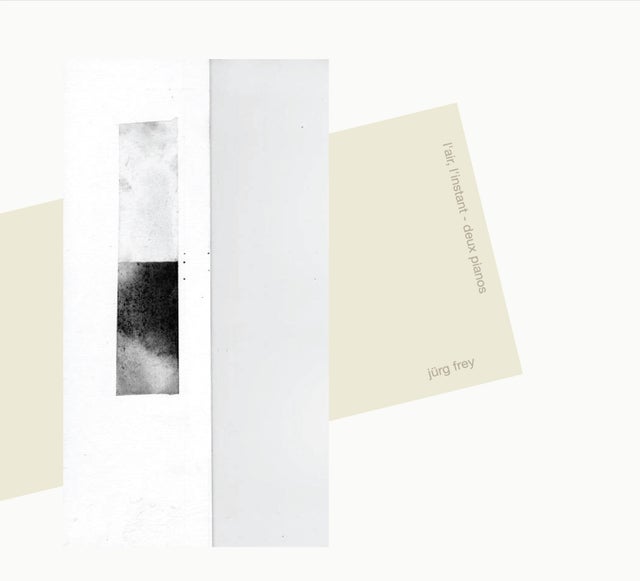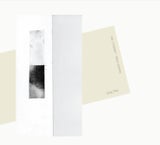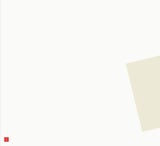- Jürg Frey
- >
- Jürg Frey - l'air, l'instant - deux pianos (Reinier van Houdt / Dante Boon) (HD)
Jürg Frey - l'air, l'instant - deux pianos (Reinier van Houdt / Dante Boon) (HD)
SKU:
$10.00
$10.00
Unavailable
per item
Digital HD FLAC (24bit/96k)
elsewhere 014
This album includes two pieces of Swiss composer Jürg Frey, written for two pianos in 2017-2019: ‘Entre les deux l'instant’ (2017/2018) and 'toucher l’air' (deux pianos) (2019), performed by two Dutch pianists Reinier van Houdt and Dante Boon. Cover artwork by Sylvain Levier, design by Yuko Zama.
For CD format, go to this page.
For Lossless Digital AIFF (16bit/44k), go to this page.
*Streaming only available on Bandcamp.
|
(*sample clip is 48k/24bit mp3)
TRACK INFO
1. toucher l’air - part 1 2. toucher l’air - part 2 3. toucher l’air - part 3 4. toucher l’air - part 4 5. toucher l’air - part 5 6. toucher l’air - part 6 7. toucher l’air - part 7 8. Entre les deux l'instant (released November 11, 2020) CREDITS
compositions by Jürg Frey Reinier van Houdt - piano 1 Dante Boon - piano 2 recorded by Luke Deane and Hans van Eck at Splendor, Amsterdam, September 9, 2019 mixed and mastered by Taku Unami cover art by Sylvain Levier design by Yuko Zama produced by Yuko Zama p+c 2020 elsewhere music Jürg Frey's music is published by Edition Wandelweiser. www.wandelweiser.de |
Jürg Frey’s unique compositional approach places him at the cutting edge of contemporary classical music. Since the late 90's, Frey started to work with 'lists' as a basis of his compositions, sometimes words, sometimes chords, from which he developed and organized musical materials. In recent years, Frey's focus on 'lists' has extended more toward the connections of items with each other, forming melodies.
Frey wrote two compositions for two pianos in 2017-2019: ‘Entre les deux l'instant’ (2017/2018) and 'toucher l’air' (deux pianos) (2019). ‘Entre les deux l'instant’ was world-premiered by Dutch pianists Reinier van Houdt and Dante Boon at Splendor Amsterdam and was later recorded there together with 'toucher l’air' by the same two pianists in the presence of Frey in Amsterdam in 2019. The first piece on this album, 'toucher l’air (deux pianos)', was composed in close connection to Frey’s previous composition 'Entre les deux l'instant'. This piece consists of seven movements, written for two parts for piano 1 and piano 2, in which two pianists play each part at the same time with subtle similarities but in different tempos. The interaction between the two is only vaguely shown in the score, giving this piece a mixed sense of openness and closeness, separation (or aloneness) and intimacy. The second piece on this album, 'Entre les deux l’instant', consists of two parts: ‘Melody’ and ‘List of Sounds’. Melody starts with pianist 1 (Van Houdt), then continues with pianist 2 (Boon), going back and forth between two pianists to the end. When one pianist plays Melody, the other plays a note(s) from List of Sounds given in order in the score. The pianist can also add extra notes to the Melody, to double these notes, but slightly later and softer than the sounds of Melody, like adding a slightly ‘off’ shade to it. Two parts are played simultaneously by two pianists but the timings are flexible, up to each pianist to decide, not pre-arranged nor intended to coincide precisely. Van Houdt and Boon conveyed every fine nuance of Frey’s two piano pieces with their extraordinary sensitivity and masterful skills, organically filling the two pieces with a clean tranquility and airy feeling. The album cover features French contemporary artist Sylvain Levier's minimal artwork, which perfectly resonates with Frey's extremely subtle yet profoundly captivating pieces for two pianos. The album cover features French contemporary artist Sylvain Levier's minimal artwork, which perfectly resonates with Frey's extremely subtle yet profoundly captivating pieces for two pianos. REVIEWS
John Eyles, All About Jazz Irrespective of the label it appears on—be it Elsewhere, Erstwhile, Edition Wandelweiser, Another Timbre or even Irritable Hedgehog—Jürg Frey's name on a recording long ago became a guarantee that it would be both interesting and enjoyable, whether he was credited as player, composer or both. Frey's second Elsewhere release l'air, l'instant—deux pianos is the latest example of this. On it, he is credited as composer and his music is played on two pianos by van Houdt and Boon. The hour-long album features two compositions written for two pianos, the seven-part "Toucher l'air (2019)," and "Entre les deux l'instant (2017-8)." Right from the first notes of the album, it is clear that we are in very different territory to either of the albums above. The music bears the unmistakeable hallmark of Wandelweiser, Frey being a long-standing member. The stately pace and the spaces which allow every note to be clearly heard from beginning to end are as distinctive as fingerprints. The two pianists (Boon himself being a Wandelweiser member, of course) are ideally suited to the task of playing Frey's music and they do not disappoint, sounding totally tuned into each other's brainwaves and to Frey's intentions. Altogether, simply exquisite. (10/30/2020) Alex Mayle, Tone Glow I don’t think it’s controversial to say that Jürg Frey is the most consistent composer in the Wandelweiser collective. However, I wasn’t particularly excited when I first heard about a new Jürg Frey piano album because the instrument has always felt like a weak spot for him. It was a surprise, then, when the latest Elsewhere batch came out and l’air, l’instant - deux pianos became my favorite of the batch and is becoming one of my go-to modern piano albums. Split into two pieces that were composed in relation to each other, the works here share a common theme: two piano lines in a state of quasi-linkage. The music, performed by Reinier van Houdt and Dante Boon, conjures up very strong visualizations for me: two streams running parallel, neither connected directly but following similar paths. The closer you look the more differences you see; the water in one stream is traveling slightly faster and the other curves at a minutely different angle. At a few points you can almost make out places where the rivers run in perfect sync, though it might just be your brain making connections. This description not only describes the inner workings of the music but also the overall structure of the album, as both pieces feel like they’re treading the same but distinct ground. The first piece, “toucher l’air” (touch the air), is split into seven movements and was informed by the composition of the following piece, “entre les deux l'instant” (between the two moments). On this piece, Frey exposes the romantic side of his style, akin to the work of Anastassis Philippakopoulos. Chromatic figures are seemingly traded between the two piano players, subtly shifting between them. The two piano lines are slightly out of phase, however, so the effect feels blurred across time, the inexactness inexplicably heightening the relationship between the two pianos. It’s through the differences that the connection feels clearer. There is a simple beauty to the melodies that are tossed around throughout this piece that makes the whole thing work without feeling like an academic exercise. “entre les deux l’instant” is a more enigmatic piece for me, though no less brilliant. Like the album as a whole, duality seems to play a central theme: the pianists bounce around the “Melody” while also alternating between playing from a “List of Sounds.” They modulate each as they see fit so as to not make the composition stilted. The second repetition of the “Melody” is altered in a way that reminds me a lot of the cover of the album: slight off-white and grey shades. Like the first piece, there’s a lot of back-and-forth between the two pianists, more direct this time, but still distorted during the passing. I particularly like how the album as a whole feels like a macrocosm of the ideas presented in the pieces themselves, giving the album a cohesion not often found in classical music. Dante Boon and Reinier van Houdt are both excellent interpreters and improvisers on this album, giving Jürg Frey’s ideas the nuanced playing they deserve. Sylvain Levier’s artwork and Yuko Zama’s design pair nicely with the works, and this is something Yuko Zama should be praised for more often. I’ve talked with her before on the design on The Earth and the Sky and it is very clear that she understands how the look and feel of an album affects your perception of it, particularly when it comes to abstract music. Everything culminates into this multifaceted and beautiful album. Michele Palozzo, Esoteros Why four hands? At what historical moment, for what purpose did two musicians sit at the same piano, or put two of them side by side? Except for domestic or theatrical divertissements, normally such an arrangement satisfies the need for an expansion of harmonic solutions, or an equitable sharing of complex rhythmic and melodic architectures: limiting ourselves to the late twentieth century, the range spans from Messiaen’s “Visions de l’Amen” and Boulez’s “Structures” to the circular motion of minimalist suites such as John Adams’ “Hallelujah Junction”, up to the threefold extreme of Steve Reich’s “Six Pianos”. In the midst, as in many other cases, lay an enlightened vision capable of redefining the time horizon of music, sealing a relationship between sound and silence diametrically opposite even to its coeval avant-gardes: John Cage and Morton Feldman spontaneously traced the coordinates of a poetics of reduction which in our day finds in Jürg Frey one of its most sensitive and refined interpreters, he himself having recently approached writing for two pianos. But while Cage would have reached so radical an essentiality only with his late number pieces (“Two2”, 1989), it was actually Feldman who first laid the foundations of that objectifying and rarefied aesthetics – as if perpetually suspended – which still exerts an inexhaustible influence on the composers of the Wandelweiser collective; a repertoire, which, unsurprisingly, has already been presented in dedicated albums via the Another Timbre imprint. Inscribing itself in Elsewhere’s ‘piano series’, instead, is this premiere recording by the Dutch Dante Boon and Reinier van Houdt, among the reference pianists in relation to the “vertical virtuosity” called for by reductionist scores. Entering this isolated expressive domain, a pair of musicians no longer find themselves sharing a structure, a scheme with a precise narrative or conceptual character, but more simply an acoustic and mental space, a virgin soil in which to plant the seeds of a minute and ephemeral blossoming, the most transparent and impersonal form of the verb ‘to be’. It is a timidly incremental development, in fact the one drawn by the seven movements of “toucher l’air (deux pianos)” (2019), animated by delicate gestures and overlappings of slender melodic lines, complementary in their ever-changing time lag. From the third movement onwards, the crisscross counterpoint becomes alternately more present and regular, like a water surface that ripples under the influence of a silent breeze, and then again smoothes out in a colorless yet supremely melancholic stillness. The winter of the soul has an inconstant breath, gleams from its own solitude and intensifies in it: the last movement – a necessarily putative conclusion – is the pure distillation of an effulgent and uncorrupted beauty, a pinnacle as close as possible to the yearned transcendence. Based on a specific process of executional interaction, yet open to indeterminacy, “Entre les deux l’instant” (2017/2018) seems to play out the intimate anguish of an encounter struggling to happen: slightly less incorporeal than in the previous piece, the two pianos seek after each other among the strokes of single keys and crystalline chords, as if braving through the unknown whiteness that separates the signs on the pentagram in order to briefly reach the other. ‘Between the two, the instant’: extremes that perpetually attract and skim each other, moving forward at the arbitrary rhythm of inner life through the irresolution of a complete sentimental abstraction. It’s the pointillistic enucleation of a romantic epos in slow motion, filtered by the white mist that shrouds all of Jürg Frey’s impalpable sound poetics, once again effused in an essay of sublime expressive grace. (11/27/20) Eyal Hareuveni, The Free Jazz Collective More than twenty years ago Swiss composer and clarinet player Jürg Frey articulated his unique compositional approach in an essay titled Architektur der Stille (Architecture of Silence), focusing on how the physical relationships between sound and silence can affect our perception of space and time: “In Silence, a space opens, which can only open when the presence of sounds disappears. The silence which is then experienced derives its power from the absence of sounds we have just heard. Thus periods of silence come into being, and then the physicality of silence. There are pieces in which the absence of sound has become a fundamental feature. The silence is not uninfluenced by the sounds which were previously heard. These sounds make the silence possible by their ceasing and give it a glimmer of content. The space of silence stretches itself, and the sounds weaken in our memory. Thus this slow breathing is created between the time of the sounds and the space of silence”. l'air, l'instant - deux pianos features two compositions for two pianos, both realize magnificiently the equisite Architecture of Silence approach: “Entre les deux l'instant” (2017/2018), premiered by Dutch pianists Reinier van Houdt and Dante Boon at Splendor Amsterdam, and “toucher l’air (deux pianos)’ (2019)”. Both were recorded by Houdt and Dante Boon in the presence of Frey in Amsterdam in September 2019. French artist Sylvain Levier's minimal artwork resonates with Frey's extremely subtle yet profoundly captivating sonic vision. The first piece on this album, “toucher l’air (deux pianos)”, was composed in close connection to “Entre les deux l'instant”. This piece consists of seven minimalist movements, Feldamn-esque in its spirit, written for two parts for the two pianos, and van Houldt and Boom play each part at the same time with subtle similarities but in different tempos. The interaction between the two parts is only vaguely shown in the score, giving this piece an elusive but strong poetic sense of openness and closeness, loneliness, and intimacy. The following piece, the 34-minutes “Entre les deux l’instant”, is more ethereal and silent than “toucher l’air (deux pianos)”, and consists of two parts: Melody and List of Sounds. Melody begins with Van Houdt, then continues with Boon, going back and forth between the two pianists to the end. When one pianist plays Melody, the other plays a note(s) from List of Sounds given in order in the score but slightly later and softer than the sounds of Melody, like adding a slightly ‘off’ shade to it. The two parts are played simultaneously by two pianists but the timings are flexible, up to each pianist to decide, not pre-arranged nor intended to coincide precisely, but allowing each sound to resonate fully and beautifully. Again, This kind of elusive atmosphere never let the music fall into familiar patterns of time and space, but suggests similar, profound meditative tranquility. (12/19/2020) |



